Drill, Glue and Sanding Fixture
In order to bind the signatures together, I developed the
multi-purpose fixture that you see described below.
Once you have assembled all of the signatures, place each
chapter in the correct order in between the jig plates as you
see below. Make sure the signatures are straight and even and
raised above the fixture by about 1/8" and then tighten the
clamp bolts. You are now ready to apply glue to the signatures
at the spine end of the book.
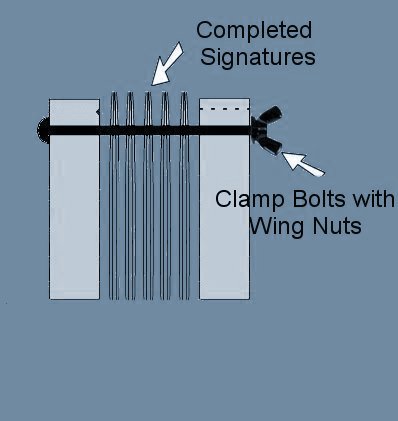
Once the glue has dried, loosen the clamps and move the signatures down flush with the top of the fixture and then re-tighten the clamp bolts With the signatures flush with the top of the fixture, you will be able to drill the holes through all of the pages of your book at exactly the correct depth from the back of the spine. Since these are very small holes that you are drilling, you do not want to force the drill too hard as it will cause the drill bit to bend and possibly break.
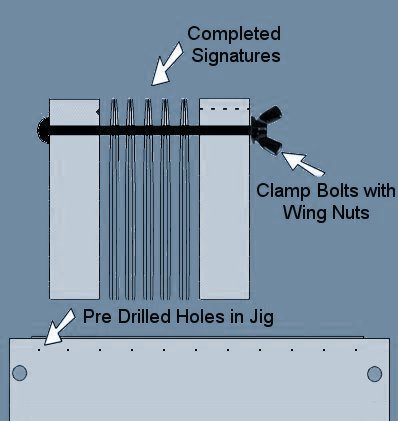
Once the holes are drilled, you are ready to sew the signatures.
I have experimented with several types of threads, each
producing different results. I first used a single heavy waxed
nylon line for this purpose. The twine measured .035 in diameter
but soon found that this was too bulky and too strong to allow
the pages to open easily. I then tried a much finer thread
pulling two strands rather than just the one thinking that the
pages would spread open more easily. My last attempt was to use
an single strand elastic type thread with a brand name of (TCH
Rite Stretch Rite). This seemed to work well allowing the pages
to lay open fully. This particular thread needs to be pulled
somewhat tight but not so tight as to remove all of the stretch.
With each of the above types of thread I sewed back and forth
through the book from one end to the other as you see below and
then repeated the process in reverse until I reached the
starting point.
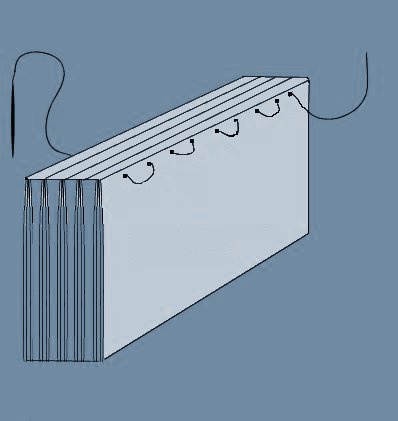
After trimming off the nylon twine ends, you can apply a 1/4"
strip of glue down the entire length of the twine on both sides
and at the same time, apply another layer of glue to the spine.
Once the glue has dried, you can add another 1/4" strip of glue
down the twine and add a blank half page to the front and back
to hide the twine. The book is now ready for the cover. The
cover of course is all one piece and needs to be the exact
dimensions of of the front, back and spine. This will
necessitate that you use paper measuring 8-1/2 x 14". A
completed cover needs to be pre-folded to the exact book
dimensions and can be added rather easily by applying a layer of
glue to the book spine and a layer inside the cover along the
spine area being careful not to get any glue spill over onto the
front or back.
What you see below is a cover that has just been glued to the
book and supported in a metal angle jig for drying. You could
just as well use a couple of large books for this purpose. Even
though this picture shows the spine end of the book up, it is
much better to place the spine end down against a flat surface
as it tends to wrinkle along the spine if it is allowed to dry
out in the open.
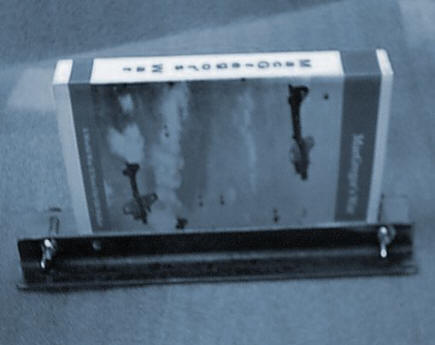
Once the glue has dried, you are ready to trim the edges of the
pages, top, front, and bottom. This fixture comes with metal
angle plates that fit along the inside of the jig as indicated
by the red angles. The reason for these plates is to prevent
removal of material from the wooden jig when you begin the
sanding process. With the rough uneven pages sticking slightly
above the top of the jig, tighten the wing nuts and use and
orbital sander to smooth the edges of the pages. This produces
an almost satin like finish on the edge of the pages
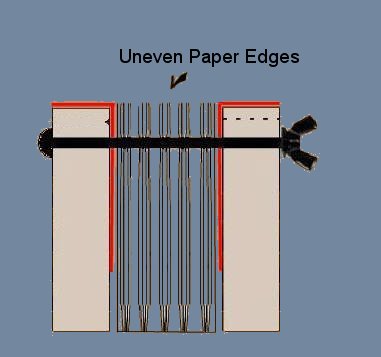
This is an actual picture of the jig ready to have the surface of the pages trimmed. If you would like to purchase this fixture, click on the image below for details.
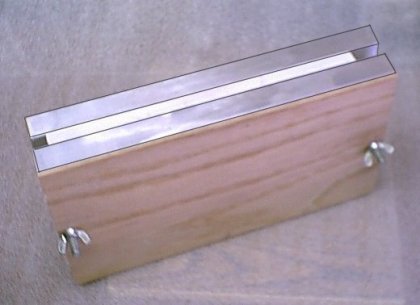
Another option is to purchase a thermal binder to apply the glue
to the spine of your books. Shown below is a
Fellows TB-450 which is ideal if you plan on doing multiple
books. I purchased one of these and it is excellent for book
binding without the use of thread. This thermal binder has 3
settings for various book sizes and when combined with the glue
strips, you can create Custom Book Covers. It takes only a
minute or less to bind a book with this machine and it has a
handy cooling rack on the back. Using the Fellows Thermal Binder
will require that you dump the signature method in that each
individual page will get glued to the spine. I ended up creating
a signature for each chapter but instead of folding it. I used a
Falcon 500 cutter (see below) to slice the 8-1/2x11 sheets
into single book pages 5-1/2 x 8-1/2. With all of the pages
stacked in their proper order, it's very easy to insert them
into a handy measuring guide on the front of the thermal binder.
This guide will display the width you need for your cover. This
thermal method of binding also requires much less sanding on the
pages.
Fellows TB-450

The Falcon 500 cutter that you see below is excellent for
slicing your sheets. This cutter has a regular single edge razor
blade in the cutting head. The blade retracts for safety. The
cutter is a bit flimsy when it stands alone but I mounted it on
a board to give it more stability and I must say, I have
abandoned my other old cutter with the arm that comes down and
slices the paper. When you are making books, you need the paper
to be sliced clean and without ripples and this cutter does just
that. You can buy this cutter at
Amazon.com
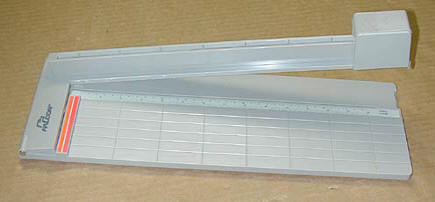
Next, let's take a look at how to
print a cover for your book or magazine.


